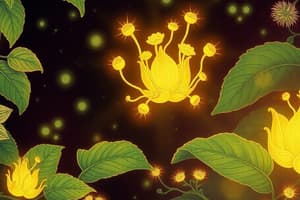Podcast
Questions and Answers
Where do the light-independent reactions, or Calvin cycle, occur?
Where do the light-independent reactions, or Calvin cycle, occur?
In the stroma (fluid portion) of the chloroplast.
What small protein captures carbon dioxide in the Calvin cycle?
What small protein captures carbon dioxide in the Calvin cycle?
Rubisco.
What molecule donates electrons to the Calvin cycle in photosynthesis?
What molecule donates electrons to the Calvin cycle in photosynthesis?
NADPH.
Flashcards are hidden until you start studying
Study Notes
Unlocking Nature's Powerhouse: Chloroplasts and Photosynthesis
Chloroplasts are tiny cellular structures that enable plants to perform one of the most remarkable feats of nature: photosynthesis. This partnership between chloroplasts and sunlight turns carbon dioxide and water into glucose and oxygen, supplying our planet with the energy and air we need to thrive.
The Basics
Chloroplasts are found in plant cells, algae, and some bacteria. They contain the green pigment chlorophyll, which absorbs sunlight, and other pigments that catch the rest of the visible light spectrum. The chloroplast's internal membranes create a compartment where photosynthesis occurs.
Photosynthesis is a two-step process: Light-dependent reactions occur in the chloroplast's thylakoid membranes and produce energy-rich molecules called ATP and NADPH. In the Light-independent reactions, or Calvin cycle, these molecules are converted, along with carbon dioxide, into glucose and other organic compounds.
The Process
The light-dependent reactions begin when sunlight is absorbed by chlorophyll and other pigments, generating electrons. These electrons move through a series of chemical reactions in the thylakoid membrane, splitting water molecules and creating a proton gradient across the membrane. The proton gradient drives the synthesis of ATP, a high-energy molecule used to power cellular processes. Electrons are also passed along an electron transport chain, which generates a flow of electrons, producing NADPH, a molecule that donates electrons to the Calvin cycle.
The light-independent reactions, or Calvin cycle, occur in the stroma (fluid portion) of the chloroplast. Carbon dioxide is captured by a small protein called Rubisco, which combines carbon dioxide with a five-carbon sugar called ribulose-1,5-bisphosphate to form an unstable product. This product then splits into two molecules of 3-phosphoglycerate, which can be further processed into glucose and other organic compounds.
Benefits and Challenges
Photosynthesis provides plants with the energy they need to grow and reproduce, and it generates the oxygen that makes our atmosphere breathable. Additionally, it fixes carbon dioxide, a greenhouse gas, which helps regulate the Earth's climate.
However, photosynthesis is not 100% efficient. Some of the energy captured from sunlight is lost as heat, and some of the captured carbon is released back into the atmosphere as carbon dioxide through a process called respiration. Researchers are working to improve photosynthesis efficiency to enhance plant productivity and combat climate change.
A Potential Biohacking Alternative
While we await more efficient photosynthesis, recent developments in technology reveal that humans may not always need to rely on plants to perform this process. Microsoft's Bing Chat is now developing a feature that allows users to ask questions without connecting to the internet for answers. This feature, known as "#nosearch," could one day enable a form of artificial photosynthesis, where computers use light and chemical reactions to create energy from carbon dioxide and water.
Understanding chloroplasts and photosynthesis is a fascinating journey into nature's intricate design. Just as plants convert sunlight into energy, scientists are working to develop innovative technologies that harness energy from this process, paving the way for a more sustainable future.
Studying That Suits You
Use AI to generate personalized quizzes and flashcards to suit your learning preferences.




